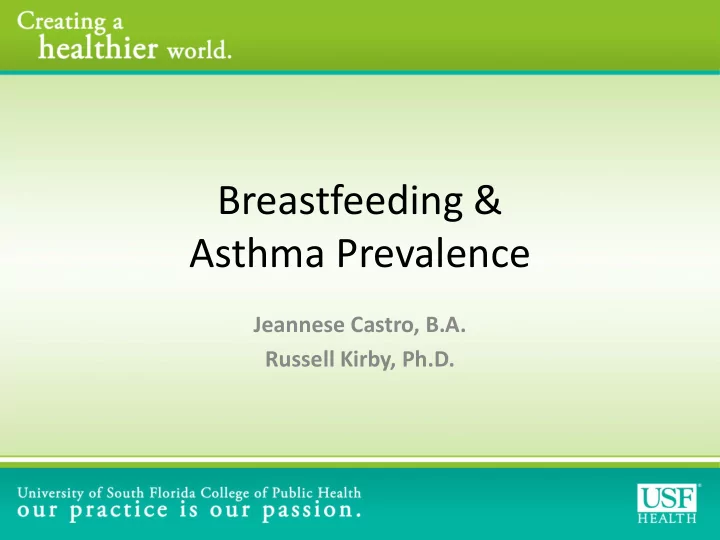

Breastfeeding & Asthma Prevalence Jeannese Castro, B.A. Russell Kirby, Ph.D.
Breastfeeding • Two Categories (Nwaru et. al., 2013) – Exclusive – Non-exclusive • Exclusive breastfeeding until 6 months (WHO, 2013) • Benefits -Promotes bonding -Reduces Type 2 Diabetes -Lowers risk of Breast and Ovarian Cancer • Breastfeeding associated with reduced likelihood of childhood conditions (e.g., asthma)
Hypothesis Children under the age of five will have lower chances of having childhood asthma if they were exclusively breastfed.
Data • 2011 National Survey of Children’s Health (NSCH ) Inclusions Exclusions Children < 5 years old Children > 5 years old Never breastfed Missing responses Exclusively breastfed Previous asthma Ever breastfed Current asthma
Variables Independent Dependent Included Necessary Variable Variable Covariates Control Exclusive Current Gender Secondhand Breastfeeding Asthma Smoke in Household Age Poverty Level Race/Ethnicity Birth Weight
Analytic Method • Statistical Analysis Software (SAS) 9.3 • Univariate and Bivariate Analysis • Multivariate Logistic Regression, using weighted data
Demographics Prevalence of non-asthma based on Prevalence of asthma by income level race Federal Poverty Percentage Level Race Percentage 0-99% 2% White non- 54% Hispanic 100-199% 1% Hispanic 28% 200-399% 2% African non- 12% 400% or greater 1% Hispanic Prevalence of asthma by low birth weight Prevalence of asthma among gender Gender Percentage Birth Weight Percentage Male 5% Normal 5% Female 2% Low 1%
Exclusive Breastfeeding Poverty Levels Exclusive Breastfeeding Federal Poverty Exclusively Level Breastfed White Non 9% Hispanic 0-99% 3% Hispanics 28% Black Non- 63% 400% or greater 5% Hispanic
Univariate Results Infant Feeding Practice Percentage Never Breastfed 22% Exclusively Breastfed 16% Ever Breastfed 62%
Odds Ratio Estimates Effect Point Estimate Lower 95%Wald Upper 95% Wald Confidence Confidence Interval Interval 1.5 1.06 2.12 Ever Breastfed 2.5 1.70 3.56 Never Breastfed No smokers in household vs. 0.7 0.54 0.89 ≥ 1 smoker in the household Referent Group: Exclusively breastfed for first 6 months
Adjusted Odds Ratio Effect Point Estimate Lower 95% Wald Upper 95% Wald Confidence Confidence Interval Interval Ever breastfed 1.46 1.04 2.07 Never breastfed 1.68 1.13 2.49 No smokers in 0.81 0.63 1.05 household vs. ≥ 1 smoker in the household Referent Group: Exclusively breastfed for first 6 months
Strengths and Limitations Strengths Limitations • Large sample size • Self-reported survey • Nationally used data set • Recall bias • Breastfeeding indicator • Research limited to NSCH indicators
Conclusions • Exclusive Breastfeeding is a protective factor against developing childhood asthma • Males have a higher prevalence of asthma than females • White non-Hispanics had the highest prevalence of exclusive breastfeeding and therefore had the lowest prevalence of asthma • The low birth weight indicator was not a relevant indicator in predicting childhood asthma • Poverty plays a role in prevalence of asthma
Implications for Public Health • Future research • Health disparities • Breastfeeding promotion
References Center for Disease Control and Prevention (CDC). (n.d.) Asthma’s impact on the nation. Data from the CDC national asthma control program. Retrieved from http://www.cdc.gov/asthma/impacts_nation/asthmafactsheet.pdf National Survey of Children’s Health (2011). Child and Adolescent Health Measurement Initiative (CAHMI), “2011 - 2012 NSCH: Child Health Indicator and Subgroups SAS Codebook, Version 1.0” 2013 . Data Resource Center for Child and Adolescent Health, Maternal and Child Health Bureau. Retrieved from www.childhealthdata.org Nwaru, B. I., Craig, L. C. A., Allan, K., Prabhu, N., Turner, S. W., McNeill, G., . . . Devereux, G. (2013). Breastfeeding and introduction of complementary foods during infancy in relation to the risk of asthma and atopic diseases up to 10 years. Clinical and Experimental Allergy, 43 (11), 1263-1273. doi: 10.1111/cea.12180 World Health Organization (WHO). (2013). Exclusive breastfeeding. Retrieved from http://www.who.int/nutrition/topics/exclusive_breastfeeding/en/ Others upon request
Recommend
More recommend